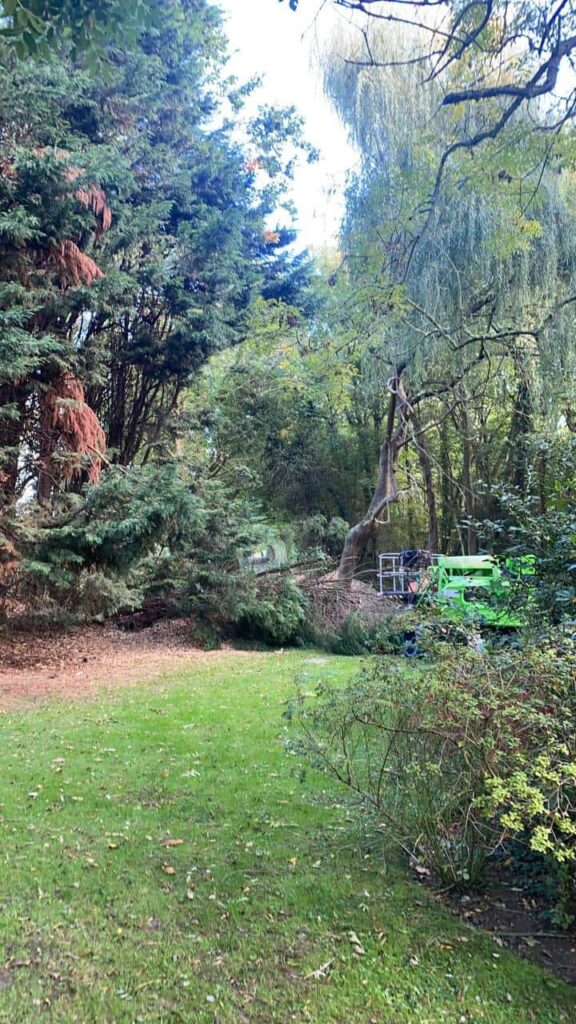Introduction
Trees are vital to the beauty and health of any outdoor space—but when one becomes unstable, it can quickly go from an asset to a serious hazard. In Sudbury, Suffolk, where mature trees are often close to homes, roads, and gardens, recognising early warning signs can prevent significant damage or even injury.
At Sudbury Tree Surgeons, we’ve seen the damage a fallen tree can cause—and more often than not, there were visible clues beforehand. This article outlines the top 10 signs that a tree may be at risk of falling, helping you stay proactive and protect what matters most.
Key Takeaways
- A leaning tree may indicate root failure or instability
- Cracks, cavities, and peeling bark are signs of structural weakness
- Fungal growth and root exposure point to internal or underground decay
- Deadwood, falling branches, and pest activity often signal serious health issues
- Timely professional assessment can prevent damage and save lives
1. Leaning Tree
Not all leaning trees are dangerous, but a sudden or increasing tilt is often a red flag. A lean over 15 degrees, especially with uplifted soil around the base, can indicate failing roots or structural imbalance that may lead to collapse.
2. Cracks in the Trunk or Major Limbs
Visible splits or deep cracks in the trunk suggest internal damage that compromises stability. These often develop after storms or under the strain of overgrowth and should never be ignored.
3. Dead or Falling Branches
Large dead limbs or unexpected limb drop can be the tree’s way of relieving internal stress. This usually points to poor health or damage inside the canopy and may precede a full tree failure.
4. Fungal Growth at the Base
Fungi, especially large mushrooms or conks at the base, are often signs of root or internal trunk decay. These organisms feed on dead or dying wood, indicating the tree’s structural core may be compromised.
5. Soil Movement or Heaving
If the ground around a tree appears raised, cracked, or shifting—especially after storms—it may be a sign that the root plate is loosening. This is one of the clearest indicators a tree could fall.
6. Hollow or Cavities in the Trunk
Hollow trunks can sometimes remain stable, but they significantly reduce the tree’s strength. Combined with cracks or visible decay, a hollow is a serious warning sign, particularly in older trees.
7. Peeling or Missing Bark
Bark acts as a protective layer. When it begins to peel off in large sections or exposes dead wood underneath, the tree may be in serious decline. This often occurs alongside disease or pest damage.
8. Exposed or Damaged Roots
Roots that are broken, eroded, or visibly decaying compromise the tree’s anchor. Tree roots damaged by foot traffic, construction, or waterlogging are less able to hold the tree upright during high winds.
9. Sparse or Discoloured Leaves
Patches of yellowing, sparse, or early-dropping leaves can indicate declining tree health, especially if the rest of the canopy appears stressed. It’s often a symptom of deeper root or internal problems.
10. Visible Insect Infestation
Insects like bark beetles, carpenter ants, and wood-boring larvae attack weakened or dying trees. Sawdust around the base, bore holes, or visible pests are clear signs that a tree is struggling to defend itself.
Conclusion
A failing tree doesn’t always fall without warning—but you need to know what to look for. By spotting the early signs of instability, you can take action before it becomes a serious risk to people or property. If any of the signs above are present on your property, don’t wait.
At Sudbury Tree Surgeons, we offer expert inspections, precise pruning, and safe removals throughout Sudbury and Suffolk. Contact us today for a professional tree assessment—we’re here to help keep your surroundings safe, sound, and standing strong.
Call us on: 01787 322 388
Click here to find out more about Sudbury Tree Surgeons
Click here to complete our contact form and see how we can help with your tree needs.

